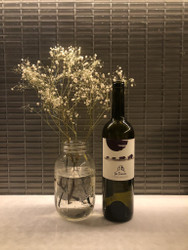The Outsiders: Wine Edition
Posted by Veronika Jelenik on January 25 2022 6:13pm
The story behind Los Comuns, the producer of this week’s bottle, “Estrem,” could easily be written into a novel that’s then made into a movie. It follows two childhood best friends, Jordi Escoda and Agustí Perelló, who were born and raised in El Molar, a village in Priorat, Spain. Being from El Molar earned them the nickname “los comuns,” a derogatory term for children from the village. It derived from the 1800s when a cholera epidemic hit El Molar, forcing kids from the area to wear smocks identifying themselves so the other children could stay away.
Instead of lamenting their outsider status, the two grew to relish it. They decided to start making wine together, producing their first 200 bottles in 2010 and dubbing their bodega “Los Comuns.” Despite operating within the Priorat D.O., the two chose to deny their appellation status and identify as Vino de la Mesa instead.
Now, just over a decade later, they produce three cuvees—Estrem, Bateta, and Carinyos—from old Carinyena and Garnacha vines. They differ from traditional Priorats in that they are less classic and less oaky, probably due to their choice to ferment and age the wines in amphora (clay) tanks and old casks. All the grapes are dry-farmed and hand-harvested, and the vineyard produces just 3,500 bottles per year using organic and biodynamic farming methods (though uncertified). All wines are unfined/unfiltered and contain no added sulfites.

Jordi Escoda and Agustí Perelló of Los Comuns in Priorat, Spain.
I chose to try Estrem out of the three because of its production method. At the start of fermentation, the grapes—70 percent Carinyena and 30 percent Garnacha—undergo carbonic maceration for 10 days. If you’re unfamiliar with carbonic maceration, which admittedly I was until roughly six months ago, it’s the same fermentation process used to make most fruity Beaujolais wines. I thus wrongly assumed this wine would be a lighter, less tannic, more fruit-forward Spanish wine than the one’s I’d tried in the past.
While I wasn’t completely off target—this wine did have a pronounced fruitiness and freshness—it defied my expectations with savory, earthy notes that I couldn’t easily identify. I will concede that I am not very familiar with Spanish wines, particularly Priorats, so I wasn't entirely sure what was coming. Despite that, this wine was objectively idiosyncratic.
I chose to indulge in the bottle this Sunday during my weekly Euphoria watch party with friends from the shop. Upon opening it, I realized it wasn't necessarily a fun, easy drinker for a kick-back with friends. It was more serious than that, something I would recommend giving more attention to than I did. For example, my food pairings included Trader Joe’s fried mac and cheese balls, frozen pizza, and potato chips.
On the nose, it was slightly “funky,” or, what my coworker Michael more aptly described as “skunky.” It was subtle, though, and the strongest notes I got were pine, herbs, and spice mixed with prune and blackcurrant. It also had a floral essence; not a bouquet, but more like a field of overgrown weeds and wildflowers.
It was just a touch fruitier on the palate than on the nose; think black and blue berries, plums, and raisins. It had a long, mouth-drying, tannic finish, though the tannins were well-balanced with a lip-smacking acidity. On both the nose and palate it was a little “hot” (as in, alcoholic), so this is a wine I would decant.
The lingering taste was dusty and minerally, and it was apparent it had been finished in amphora. In all, this wine was rather enigmatic, and I would drink it differently if given the opportunity. For under $30 a bottle, it’s definitely one to keep on your radar. And, if I’m being honest, the bromance behind it definitely sold it for me.

